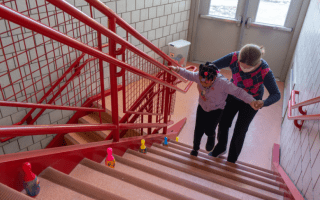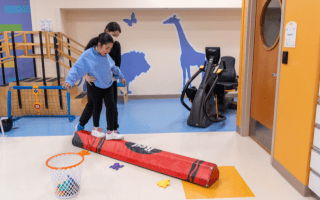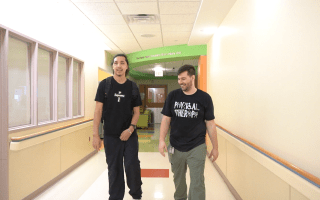Joshua's Story: Creating Ability Through Assistive Technology
Through Assistive Technology, Joshua's limitations became limitless
Eighteen-year-old Joshua has Chronic Inflammatory Demyelinating Polyneuropathy (CIDP), a rare neurological disorder that causes progressive weakness and impaired sensory function in the legs and arms. For Joshua, the disease has impacted his movement and coordination, and led to weakness in his hands. After a recent spinal surgery to correct scoliosis, Joshua was admitted to Blythedale Children’s Hospital for comprehensive post-surgical rehabilitation. Kelly Milano, OTR/L, his occupational therapist, assessed his ability to independently access his environment and learned that Joshua was unable to change the channels or the volume on the TV in his room. To do so, he'd have to wait for a member of the Blythedale staff to help him.
Milano consulted with JeanMarie Florkowski, OTR, ATP, a senior occupational therapist at Blythedale, and the Hospital’s Assistive Technology team to find a solution for Joshua.
“As part of the Assistive Technology team, we are available to support and consult with the primary therapist on their children and what their needs are, whether it be seating and positioning, communication or, in this case, for Joshua it was for environmental access,” said Florkowski.
The team introduced Joshua to “Puck”, a smart remote that allows Joshua to control his TV through Bluetooth technology via an app on his phone or tablet. The commercially sold device was originally made for the average household as a means to consolidate remote controls and simplify the user experience. But as Florkowski points out, “it actually ended up benefiting those with motor impairments.”
“Technology is my life,” said Joshua.
Already a tech wiz, Joshua instantly downloaded the app and started flipping through his favorite channels, including Nickelodeon and the Disney channel, by pressing the buttons on his phone or using the voice control to adjust the volume or shut off the TV.
“I’m just so proud of Joshua,” said Milano. “He took hold of using all of this technology and he’s very vocal about how to change things himself for the better.”
“The therapies all work together every day,” she said. “I work with the other occupational therapists in my department, and we’re always talking about our cases and communicating about what we can do differently and what we can do better. The other nice thing about working at Blythedale is that I can work with the physical therapist and the speech therapist on a daily basis to get the most beneficial treatment planning done for the child.”
According to Florkowski, the world of AT is ever changing.
“We have a very interdisciplinary approach and a strong team that has different perspectives and backgrounds in regards to using AT, which makes the problem solving for every child that much stronger,” she said. “Our approach enables us to look at all the different avenues of assistive technology support. Being able to not just work one-on-one with the child, but also have the backing of a team to support any of the needs of our patients is really crucial to the success of using AT.”



